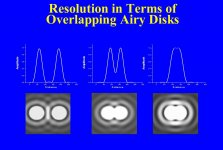Interesting how some of the bright objects in the JWST pic are not even present in the HST image. I guess these must be in the deep IR spectrum and very far back in time - so not visible to HST.
Comparing jwst and hubble is like comparing lion with orcas. Both kings in there respective environment
There can surely be no question regarding the advantages JWST has over Hubble, Steve.
Webb is designed to penetrate cosmic dust, image faint objects and peer further back in time.
It was the JWST's resolution capabilities that were questioned, and I hope that matter has been resolved!
Webb is designed to penetrate cosmic dust, image faint objects and peer further back in time.
It was the JWST's resolution capabilities that were questioned, and I hope that matter has been resolved!
Regardless which is better, I'm not satisfied with the resolution of either. That's the point. In any case to my eye the JWST may have more to show but the Hubble in some ways is still better. The JWST is grainy/pixelated in comparison. It almost appears like early digital vs film. Sure I clearly expect too much but this is the early analytical stage so criticism is fair game.
Its looking back to 300 000 yrs after the big bang. Are you not excited about that? The images are quite incredible IMV. 🙂Regardless which is better, I'm not satisfied with the resolution of either. That's the point. In any case to my eye the JWST may have more to show but the Hubble in some ways is still better. The JWST is grainy/pixelated in comparison. It almost appears like early digital vs film. Sure I clearly expect too much but this is the early analytical stage so criticism is fair game.
Yes of course they are spectacular. Discovery keeps you on the edge of your seat. I suppose on a site like DIY imperfections are a focal point.
Steve, not only is Becky relentlessly enthusiastic, but for my money less impressed by her own brilliance as, say, Dr. Neil.
We should distinguish between optical resolution and pixel resolution.
Optical resolution determines whether a telescope's optical system can separate two objects and distinguish them as individuals.
As explained earlier, the JWST can have better, equal or worse optical resolution than Hubble depending on the wavelength of light being observed.
Pixel resolution, on the other hand, refers to the total number of pixels in a digital image. However, the link below suggests there is more to Webb's sensors than mere pixel count!
https://jwst.nasa.gov/content/about/innovations/infrared.html
What is of great importance in Webb's case is its spectral resolution, i.e., the ability to resolve features in the electromagnetic spectrum. This is because a major task of Webb is to use spectroscopy to study the compositions of distant galaxies and the atmospheres of exoplanets.
Optical resolution determines whether a telescope's optical system can separate two objects and distinguish them as individuals.
As explained earlier, the JWST can have better, equal or worse optical resolution than Hubble depending on the wavelength of light being observed.
Pixel resolution, on the other hand, refers to the total number of pixels in a digital image. However, the link below suggests there is more to Webb's sensors than mere pixel count!
https://jwst.nasa.gov/content/about/innovations/infrared.html
What is of great importance in Webb's case is its spectral resolution, i.e., the ability to resolve features in the electromagnetic spectrum. This is because a major task of Webb is to use spectroscopy to study the compositions of distant galaxies and the atmospheres of exoplanets.
Here's a perfect analogy: I replaced my worn out Philips shaver with their newest sota development...$300.00..wow!..youza! I was proud to buy it...made in..you guessed it, the Netherlands. So I do my first shave...wtf?? I go back to the old one til it's just unusable(I should have just replaced the heads, the shave was tooo close but it was old anyway). So this newest iteration doesn't shave you cleanly, but it actually shaves your whiskers longitudinally thinning them..very weird. Even more weird is it does so without 'pulling' on your whiskers. I've done everything I can to discover how this thing works to no avail. It leaves you with 'peach fuzz'. Because I waited too long, I could not return it. So I bought a different model..$200.00 made in China..but still Philips. Works awesome as a Philips should so I tried the heads in my sota Netherlands model. Guess what?? They're interchangeable but you have to use the original retainers(they're different). So I took back the newer one and ordered replacement heads for $50 bucks on amazon. SH71 for those to whom it may concern.
moral of the story...I think you got it. 🤨
moral of the story...I think you got it. 🤨
I have no chest hair. I tried to acquire some by shaving what I had to encourage growth when I was 16.
BIG mistake!
BIG mistake!
Hairs are sign of inefficient heat output from body . If you want hairy chest you can try bathing several times a day with cold water . This will force your body to gain fat all across you skin . Result in higher heat resistance between body and ambiance. Result in hair growth to compensate the resistance.
Adding this
Crop of a single 1 second exposure using the 2x on m42 trapezium. Note the aligned was fixed after... but there's separation on E without any processing and it looks like (with good conditions+alignment) that F would pop out too!
The image was at 0.80 arc sec/pixel! Dawes Limit on the scope being 1.10!

Optically it’s beyond it’s limit due to the angle per pixel. That’s with a 2x on a 4” 650fl scope (Pentax 105SDP). The camera had sensor pixels small enough to see the the limit in action (IIRC 5.2um).
the same exists with all telescopes. NASA or home.
to this thread showing optical dawes limit and resolution:We should distinguish between optical resolution and pixel resolution.
Optical resolution determines whether a telescope's optical system can separate two objects and distinguish them as individuals.
As explained earlier, the JWST can have better, equal or worse optical resolution than Hubble depending on the wavelength of light being observed.
Pixel resolution, on the other hand, refers to the total number of pixels in a digital image. However, the link below suggests there is more to Webb's sensors than mere pixel count!
https://jwst.nasa.gov/content/about/innovations/infrared.html
What is of great importance in Webb's case is its spectral resolution, i.e., the ability to resolve features in the electromagnetic spectrum. This is because a major task of Webb is to use spectroscopy to study the compositions of distant galaxies and the atmospheres of exoplanets.
Crop of a single 1 second exposure using the 2x on m42 trapezium. Note the aligned was fixed after... but there's separation on E without any processing and it looks like (with good conditions+alignment) that F would pop out too!
The image was at 0.80 arc sec/pixel! Dawes Limit on the scope being 1.10!
Optically it’s beyond it’s limit due to the angle per pixel. That’s with a 2x on a 4” 650fl scope (Pentax 105SDP). The camera had sensor pixels small enough to see the the limit in action (IIRC 5.2um).
the same exists with all telescopes. NASA or home.
optical dawes limit and resolution
I think that gpauk may be familiar with Dawes' limit, but I had to look it up! 🤓
Dawes' limit is named after English astronomer William R. Dawes (1799-1868), who was known as the "eagle-eyed" because of his acute vision.
It is a measure of the limit of resolution of an optical telescope.
https://www.optics-trade.eu/blog/rayleigh-and-dawes-resolution/
Attachments
I found the Veritasium lightbulb problem very poorly presented. Flippin' obvious that no signal travels faster than light! Honestly! 🙄
Other issues in this thread have been poorly presented too. STOP USING ACRONYMS! It wastes our time. Define your terms. I don't want to go to Google every two minutes.
Anywhoo, very interesting day at Portsmouth Central Library yesterday (Second only to Portsmouth University Library for Hard Science). I was perusing the Maths, Physics and Astronomy section, having found no interesting new Crime Novels there.
What is this treasure languishing on the public bookshelves?

Vert fine and compact Reference Book. All my little favourites there. Fourier Transform, Hyperbolic Functions. You name it!
I am currently interested in the precise definition of Mass and Angular Momentum:
https://www.quantamagazine.org/mass...t-ambiguous-by-einstein-get-defined-20220713/
I set off this morning to borrow it. Alas, they won't let it go. I must buy a copy it seems. A surprisingly (for academic books) cheap £12.99.
I questioned the Librarian why a reference book is even there. She said Portsmouth Library is short of bookspace, so tends to throw it all in together.
Other issues in this thread have been poorly presented too. STOP USING ACRONYMS! It wastes our time. Define your terms. I don't want to go to Google every two minutes.
Anywhoo, very interesting day at Portsmouth Central Library yesterday (Second only to Portsmouth University Library for Hard Science). I was perusing the Maths, Physics and Astronomy section, having found no interesting new Crime Novels there.
What is this treasure languishing on the public bookshelves?
Vert fine and compact Reference Book. All my little favourites there. Fourier Transform, Hyperbolic Functions. You name it!
I am currently interested in the precise definition of Mass and Angular Momentum:
https://www.quantamagazine.org/mass...t-ambiguous-by-einstein-get-defined-20220713/
I set off this morning to borrow it. Alas, they won't let it go. I must buy a copy it seems. A surprisingly (for academic books) cheap £12.99.
I questioned the Librarian why a reference book is even there. She said Portsmouth Library is short of bookspace, so tends to throw it all in together.
- Status
- Not open for further replies.
- Home
- Member Areas
- The Lounge
- What is the Universe expanding into..

